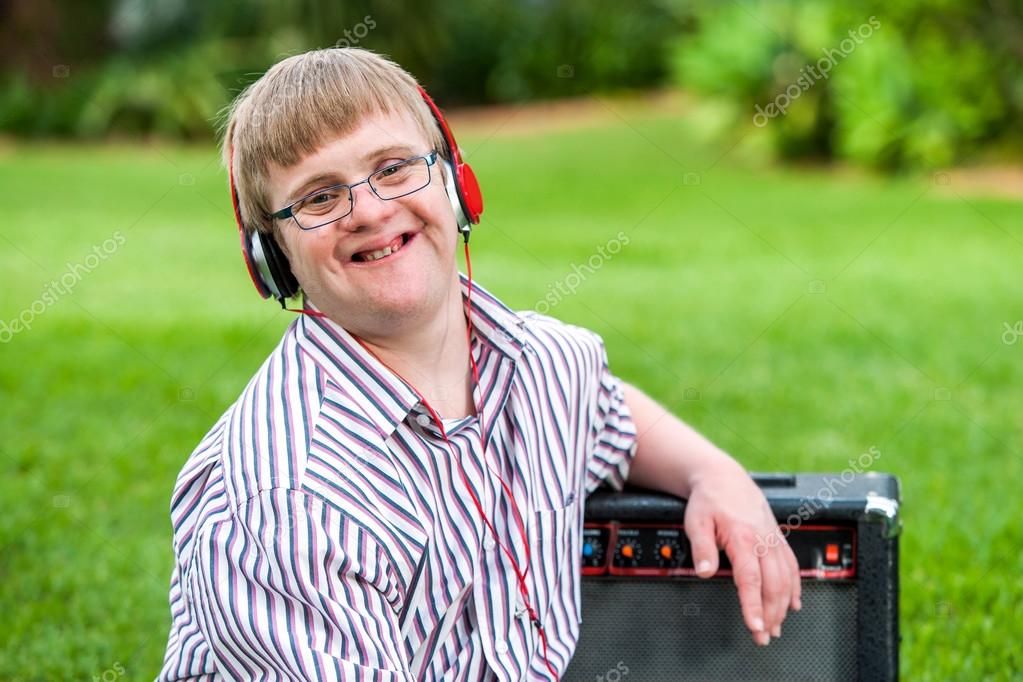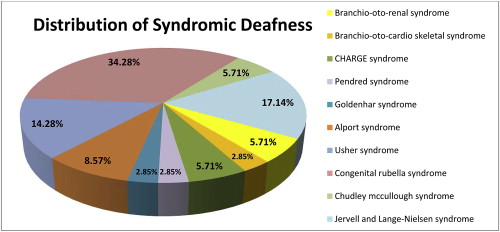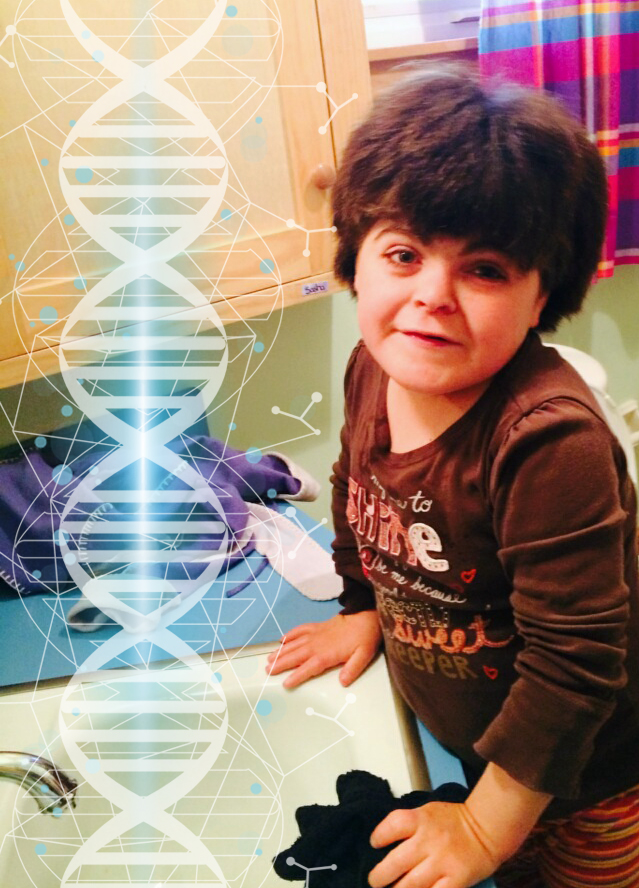6.1.6 Down’s Syndrome and Other Genetic Syndromes
What is Down’s Syndrome?

A chromosomal disorder which affects hearing, language, mental and social development
Down syndrome is a developmental disorder caused by a chromosomal abnormality which affects mental and physical development. People with Down’s Syndrome usually have limited sensory reception, particularly in hearing. They have smaller ear canals and are very prone to ear infections and wax blockage.
There is an extra, critical portion of the number 21 chromosome present in all, or some, of the cells of people with Down syndrome. This additional genetic material alters the course of development and causes the characteristics associated with the syndrome.
Typical physical characteristics include
- Muscle hypotonia, low muscle tone
- Flat facial profile, and a small nose
- An upward slant to the eyes
- An abnormal shape of the ear
- A single deep crease across the centre of the palm
- Hyper flexibility, an excessive ability to extend the joints
- Dysplastic middle phalanx of the fifth finger, fifth finger has one flexion furrow instead of two
- Excessive space between large and second toe
- Enlargement of tongue in relationship to size of mouth

Seventy five percent of children with Down’s syndrome have a hearing impairment. This is most often due to recurrent middle ear infections and wax impaction. Repeated chronic middle ear infections result in fibrous adhesions which limit the movement of the ossicles resulting in progressive hearing loss.
Children with Down’s Syndrome are significantly affected by sensory deprivation and they need preventative measures if they are to reach their full cognitive potential. A delay in the comprehension of language results in a delay in speaking.
The impairment of language abilities delays learning in all areas and makes the task of education and socialisation more difficult. This may result in behaviour problems which could be avoided if the language abilities were improved.
Ear infections: Children with Down syndrome are highly prone to ear infections and upper respiratory tract infections This is due both to a depressed immune system and certain structural considerations:
- Small Eustachian tube
- Contracted nasopharynx
- Narrow external ear canal
It is extremely important to address these problems from the beginning to avoid increased loss of hearing in the developmental stages.
Hearing
The incidence of hearing loss among individuals with Downs Syndrome is 60-75%.
Conductive hearing loss is due to poor functioning of the middle ear apparatus, which consists of bones, muscles and the ear-drum. The micro-massage provided by Sound Therapy can help significantly to keep these mechanisms in top form, and improve conductive hearing. It also helps to keep the Eustachian tube open, reducing blockages and infections of the middle ear.
The importance of this intervention for a child with Down syndrome cannot be over-emphasised. Many children with Down syndrome have more difficulty with expressive language than they do with receptive language; that is, understanding is usually more advanced than speech. The home based Sound Therapy program, offering a range of stories and music, is very beneficial as it helps to develop language and listening skills at the same time as exercising the ear

It is vitally important with Down syndrome children to avoid middle ear infections so that the child is not disadvantaged in hearing during crucial developmental phases. Even mild hearing loss is important as it will affect the learning and communication ability of a child struggling to catch up with the rest of the world.
Otitis media, middle ear infection, produces a temporary hearing loss which can go unnoticed but has measurable detrimental effects on educational development. Antibiotics will normally be recommended as a treatment for middle ear infections. These should be used with discretion as too many antibiotics will affect the child’s immune system.
Grommets or ventilation tubes. Another treatment offered to overcome recurrent ear infections is the insertion of grommets—little plastic tubes which puncture the ear drum, allowing fluid to drain out. These have mixed results, for while they may reduce the impact of otitis media, they do cause trauma to the ear and may interfere with the natural ability of the middle ear to release pressure through the Eustachian tube.
How does Sound Therapy help with Down’s Syndrome?

Enhances ear function, hearing and language ability.
Sound Therapy is very important for children with Down’s Syndrome to assist with language development. It can help to keep the ears clear and prevent or slow down progressive hearing loss. When hearing and language ability improve it makes a significant difference to the abilities and behaviour of the child.
Regular use of Sound Therapy from an early age, is a safe, non-invasive way to stimulate the middle ear apparatus and reduce infections and blockages. In addition, the diet must be kept healthy to support the immune system and avoid food intolerances. The addition of nutritional supplements is of benefit in supporting dietary balance.
The protection and enhancement of hearing that may be achieved through Sound Therapy could have significant results for all areas of development of children with Down’s syndrome. Improved hearing leads to a greater interest in the environment and what is happening, more liveliness and more willingness to learn. Language comprehension and speech improve significantly, and because the links between learning language and learning about the world are direct, the child’s education and performance in all areas will be enhanced.
People with Down syndrome may have many barriers to effective communication. The receptive language skills of children with Down syndrome—how well they understand what is being said—are often much stronger that their expressive language skills, i.e. how well they can say it. Parents often comment, ‘He knows what he wants to tells us, he just can’t seem to put the words together, or we can’t make out what he is saying.’ Classroom participation is therefore more difficult as well. The child may express his frustration by acting out or by inattention.
When Sound Therapy is introduced and listening and communication become easier, changes are seen in all levels of behaviour and social participation.
The regular use of Sound Therapy, and correct diet, may even remove the need for grommets or antibiotics, resulting in a much healthier, happier child. Chronic inflammation of the sinus cavities has also been found to respond very favourably to Sound Therapy in both children and adults.
It is very important to have a child’s hearing assessed at an audiology clinic, as the fitting of a hearing aid at an early age will greatly assist development. Sound Therapy can still be used in conjunction with a hearing aid, and will enhance the results that can be achieved from the aid
Other genetic syndromes
Each cell in the human body contains 23 pairs of chromosomes. A child inherits one set of pairs from the father and one set from the mother. Each chromosome is made up of many genes, about 2,000 in each chromosome, for a total of 50,000 genes in each cell. These genes make all the proteins in the body, which promote development and growth, and carry out all body functions.
When one or more of these genes or chromosomes is missing or mutated, or if extra chromosomes are present, the proteins may not get made, may be made incorrectly, or too many may be made. Any of these situations can cause abnormal development and can result in a genetic syndrome. Sometimes these abnormal genes or chromosomes are passed down from a parent, and sometimes they occur spontaneously without any known cause.
There are over 6,000 genetic syndromes, many of which are severely debilitating, and several of which will affect hearing, language abilities and brain performance. The most well known, as it is the most common, is Down’s syndrome.
The syndromes most commonly associated with hearing loss include:
Branchio-oto-Renal syndrome, CHARGE syndrome, Crouzon syndrome, Down’s syndrome, Goldenhar syndrome, Jervell and Lange Nielsen syndrome, Pendred syndrome, Stickler syndrome, Treacher Collins syndrome, Usher syndrome, Waardenburg syndrome.
Each syndrome has a specific prognosis and may have long or short term effects on a child’s development and hearing and communication abilities.
For children with any of these syndromes, Sound Therapy is likely to be of benefit. It may help with sensory processing, language development, hearing, coordination, emotions, communication and brain development.


